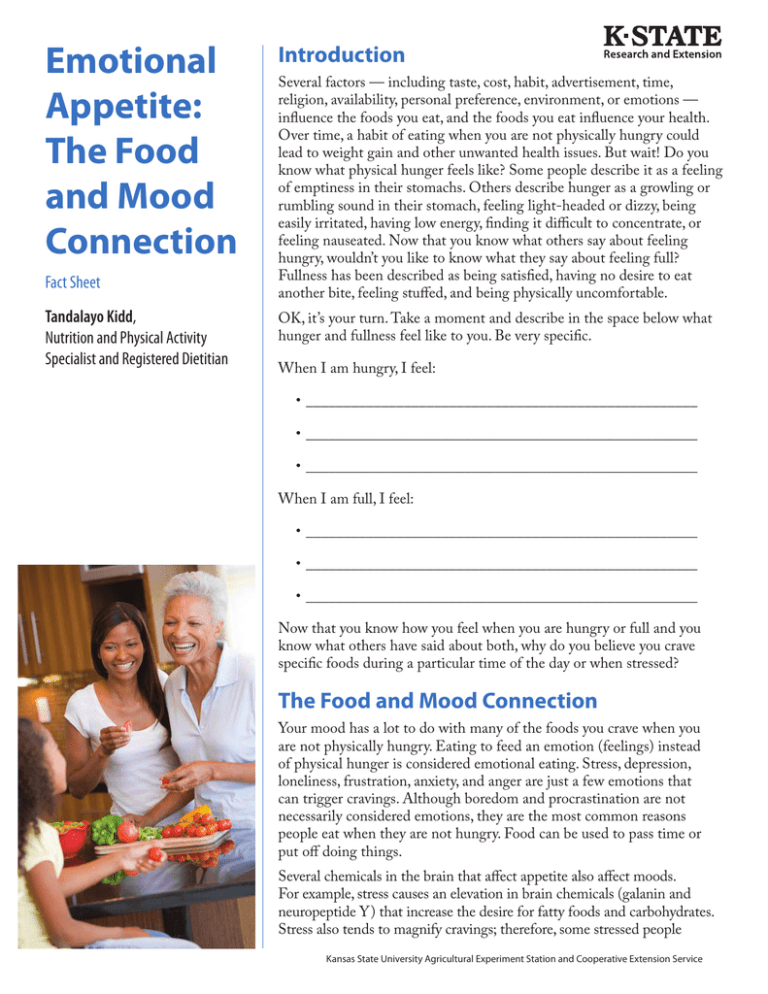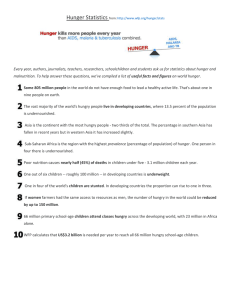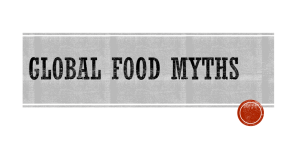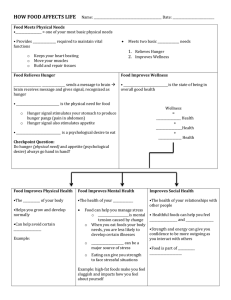
Emotional
Appetite:
The Food
and Mood
Connection
Fact Sheet
Tandalayo Kidd,
Nutrition and Physical Activity
Specialist and Registered Dietitian
Introduction
Several factors — including taste, cost, habit, advertisement, time,
religion, availability, personal preference, environment, or emotions —
influence the foods you eat, and the foods you eat influence your health.
Over time, a habit of eating when you are not physically hungry could
lead to weight gain and other unwanted health issues. But wait! Do you
know what physical hunger feels like? Some people describe it as a feeling
of emptiness in their stomachs. Others describe hunger as a growling or
rumbling sound in their stomach, feeling light-headed or dizzy, being
easily irritated, having low energy, finding it difficult to concentrate, or
feeling nauseated. Now that you know what others say about feeling
hungry, wouldn’t you like to know what they say about feeling full?
Fullness has been described as being satisfied, having no desire to eat
another bite, feeling stuffed, and being physically uncomfortable.
OK, it’s your turn. Take a moment and describe in the space below what
hunger and fullness feel like to you. Be very specific.
When I am hungry, I feel:
•____________________________________________________
•____________________________________________________
•____________________________________________________
When I am full, I feel:
•____________________________________________________
•____________________________________________________
•____________________________________________________
Now that you know how you feel when you are hungry or full and you
know what others have said about both, why do you believe you crave
specific foods during a particular time of the day or when stressed?
The Food and Mood Connection
Your mood has a lot to do with many of the foods you crave when you
are not physically hungry. Eating to feed an emotion (feelings) instead
of physical hunger is considered emotional eating. Stress, depression,
loneliness, frustration, anxiety, and anger are just a few emotions that
can trigger cravings. Although boredom and procrastination are not
necessarily considered emotions, they are the most common reasons
people eat when they are not hungry. Food can be used to pass time or
put off doing things.
Several chemicals in the brain that affect appetite also affect moods.
For example, stress causes an elevation in brain chemicals (galanin and
neuropeptide Y) that increase the desire for fatty foods and carbohydrates.
Stress also tends to magnify cravings; therefore, some stressed people
Kansas State University Agricultural Experiment Station and Cooperative Extension Service
Brain Chemicals
Associated with Appetite
Dopamine and norepinephrine: Released
after eating proteins (meat, poultry,
seafood, beans and peas, eggs, processed
soy products, nuts, and seeds). High levels
increase alertness, concentration, and stress
management. Low levels cause depressed
feelings, irritability, and moodiness.
Endorphins: Released during exercise (and
some researchers believe it’s also released
after eating sugary and fatty foods). High
levels produce a euphoric or pleasurable
feeling (natural “high”). Low levels increase
desire to seek pleasure via junk food (cakes,
candies, cookies, sweets, etc.), excess
exercise, or alcohol.
Galanin: Triggered by stress. High levels
increase the desire to eat fatty foods (creamy
foods, chips, French fries, chocolate, fatty
meats, etc.).
Neuropeptide Y (NPY): Triggered by stress.
Increases desire for carbohydrate-rich foods.
Serotonin: Released after eating
carbohydrates (whole grains, refined grains,
fruits, vegetables, and sweets). High levels
improve your mood, satisfy cravings, lessen
depression, and increase relaxation. Low
levels cause insomnia, depression, aggressive
behavior, and increased food cravings.
may eat a lot of chocolate because it has carbohydrates and fat in it. The
carbohydrate (sugar) in the chocolate causes a release of serotonin and
endorphins, which improve the mood and provide a pleasurable feeling.
The more pleasure you experience, the more you continue to indulge in
whatever provides that pleasure, and in this case, it is chocolate. The fat in
the chocolate satisfies the elevated galanin levels.
Emotional eating can get the best of anyone and can contribute to
overeating, which can lead to obesity later in life. Here is a simple chart
to help you distinguish between physical hunger and emotional hunger.
Emotional Hunger vs. Physical Hunger
Emotional
Sudden onset
Eats to feed a feeling
Craves specific foods
Eats despite fullness
Physical
Gradual onset
Eats to feed an empty stomach
No specific cravings
Stops when full or satisfied
In the space below, identify three emotions and the foods you typically eat
when they arise. For example: “Stress — chocolate-coated nuts or a juicy
hamburger” or “Bored — potato chips, candy, or cheese and crackers.”
Your personal triggers:
•____________________________________________________
•____________________________________________________
•____________________________________________________
Alternate Responses
It may take a while for you to learn how to distinguish between physical
hunger and emotional hunger, so whenever you have a desire to eat
something outside your planned meal times, do a self-check to determine
how your hunger level. If you are not experiencing any of the signs you
identified to describe your physical hunger, wait 10 to 15 minutes to see if
the desire goes away. Cravings associated with emotional hunger may go
away when you distract yourself, but symptoms associated with physical
hunger will intensify if ignored. Here are a few tips you can try if you
suspect you are experiencing emotional hunger.
•Exercise. The endorphins released during exercise will improve your
mood. Don’t forget to consult a doctor before starting an exercise
program for the first time.
•Call a friend.
•Read a book.
•Do some light cleaning.
•Go for a short walk.
•Play an instrument or listen to music.
•Brush your teeth — the fresh minty taste of toothpaste will likely
deter many sweet-related cravings.
2
Mindful Eating
the MyPlate Way
•Drink water — some people mistake thirst for hunger.
Enjoy
•Write down your thoughts and feelings.
Fruits
Lean protein foods
Low-fat and
fat-free dairy products
Vegetables
Whole grains
Consume Less
Cake
Candy
Chips
Chocolate
Cookies
Energy drinks
Fast foods
Ice cream
Pizza
Sodas
Sports drinks
Drink
100% fruit juice
100% vegetable juice
Coffee
Low-fat or skim milk
Tea
Water
•Spend time with your family or friends.
Physical Activity
Incorporating physical activity into your daily lifestyle is a great way
to relieve stress, as well as reduce your risk for some chronic diseases
and improve your overall health and fitness. Adults are encouraged
to participate in two types of physical activity (aerobic and musclestrengthening) each week. At the minimum, adults should aim for at least
150 minutes each week of moderate-intensity aerobic activities such as
brisk walking, water aerobics, or pushing a lawn mower; or 75 minutes
each week of vigorous-intensity aerobic activities such as running or
jogging, swimming laps, or playing basketball. Also, adults should do
strengthening exercises such as weight lifting, yoga, or using resistance
bands to work all major muscle groups (arms, shoulders, chest, back,
abdomen, legs, and hips) two or more days each week.
As with any workout routine, don’t forget to stretch during the warm-up
before the activity and during the cooldown after the activity. Stretching
increases flexibility and can help with relaxation because a safe stretch
is both gentle and relaxing. It is best to move slowly until you feel the
muscle stretch and then hold that stretch steady for 15 to 30 seconds.
Do not bounce. Bouncing could increase your risk for injuries. You can
repeat a stretching move three to five times. Remember to stretch within
your own limits and do not push yourself or hold your breath. Breathing
should be both slow and natural.
In the space below, identify at least one physical activity goal to help you
improve your overall health and manage stress. Be specific. For example,
“I will walk for 30 minutes after dinner 3 days a week.”
My physical activity goals:
1. ______________________________________________________
2. ______________________________________________________
Use the space below to write out steps you will take when you are feeling
emotional that will help you not turn to food. Remember, you know
what it feels like to be hungry or full. You also know what your personal
triggers are and have learned some tips to distract you when you suspect
you are experiencing emotional hunger. Be specific. The more detail you
provide, the better the plan will work for you.
When I am feeling emotional, I will: _____________________________
___________________________________________________________
___________________________________________________________
___________________________________________________________
3
If you do what you’ve
always done, you’ll get
what you always got.
Mark Twain
Emotions
Happy
Festive
Excited
Enthusiastic
Cheerful
Lighthearted
Hopeful
Peaceful
Glad
Playful
Social
Proud
Joyous
Pleased
Angry
Resentful
Enraged
Angry
Panicked
Insecure
Irritated
Frustrated
Guilty
Alarmed
Confused
Bitter
Fuming
Helpless
Anxious
Reviewers
Toni Jo Bryant, Family and Consumer Sciences
Agent, K-State Research and Extension
– Fort Riley
Kathryn Lupfer-Nielsen, Family and
Consumer Sciences Agent, K-State Research
and Extension – Post Rock District
Suspicious
Overwhelmed
Afraid
Disheartened
Overbusy
Nervous
Out of control
Tired
Overhungry
Fidgety
Impatient
Exhausted
Hurt
Injured
In pain
Victimized
Grieving
Suffering
Heartbroken
Ashamed
Crushed
Sad
Disappointed
Unhappy
Depressed
Moody
Rejected
Pessimistic
Gloomy
Discouraged
Blue
Fearful
Lonely
Sad
Low
In the dumps
Brand names appearing in this publication are for product identification purposes only.
No endorsement is intended, nor is criticism implied of similar products not mentioned.
Publications from Kansas State University are available at: www.ksre.ksu.edu
Publications are reviewed or revised annually by appropriate faculty to reflect current research and practice.
Date shown is that of publication or last revision.
Contents of this publication may be freely reproduced for educational purposes. All other rights reserved.
In each case, credit Tandalayo Kidd, Ph.D., R.D., L.P.N., and Kylie Hanson, 2011 graduate in dietetics,
Emotional Appetite: The Food and Mood Connection, Fact Sheet, Kansas State University, July 2012.
Kansas State University Agricultural Experiment Station and Cooperative Extension Service
MF3051
July 2012
K-State Research and Extension is an equal opportunity provider and employer. Issued in furtherance of Cooperative Extension Work, Acts of May 8 and June 30, 1914,
as amended. Kansas State University, County Extension Councils, Extension Districts, and United States Department of Agriculture Cooperating, Gary Pierzynski, Interim
Director.





